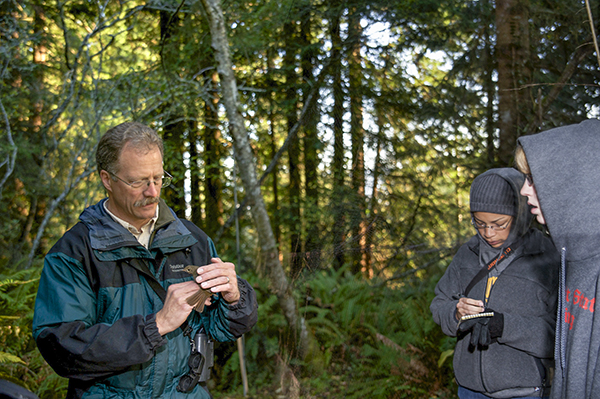
What was the impact of the West Nile Virus on birds in North America? More than 15 years after the initial outbreak of the virus, researchers have some surprising answers.
In the first in-depth study of the virus’s impacts on bird populations, HSU’s Wildlife professor emeritus T. Luke George, Washington University researcher Joe LaManna (’10 Natural Resources Wildlife), and researchers from UCLA and the Institute for Bird Populations discovered the disease killed millions of birds—many more than previously thought—and had a major, and in sometimes persistent, impact, on bird populations.
The findings were published in the Proceedings of the National Academy of the Sciences in November.
“When I started this study, I was skeptical about finding anything because so many factors affect bird survival. We anticipated a small effect of the virus,” says George, who is now a researcher at Colorado State University.
The study revealed just the opposite.
The team examined 49 bird species that were banded at more than 500 sites across North America from 1992 to 2007, before and after West Nile had arrived. They discovered that the virus affected nearly half of those species.
Researchers also found that some affected species rebounded while others didn’t. For instance, an estimated 30 million of 130 million red-eyed vireos may have died from the virus, but their population recovered.
That wasn’t the case for warbling vireos. Their survival rate didn’t just drop with the arrival of the West Nile virus but stayed low. Researchers estimate that over a five-year period, about 15 million of the 49 million warbling vireos in North America died from the virus.
The study revealed a similar long-term decline in survival for the Swainson’s thrush (a songbird commonly found in Humboldt County), purple finch, and tufted titmouse.
“Survival that is reduced and remains low for many years potentially has a long-term effect on bird populations locally, regionally, and across their range,” says George.
The results were troubling and, in some cases, surprising. Researchers didn’t expect such low survival rates for Swainson’s thrushes in Humboldt County, where the virus wasn’t prevalent due to the cool, wet climate.
Researchers haven’t determined why certain birds fared better than others.
“Perhaps some species had a natural immunity to the virus, and others may have eventually developed an immunity in a year or two. Others couldn’t successfully fight the virus and kept dying,” LaManna says. As an HSU graduate student, he helped George band birds, including the Swainson’s thrush, at HSU’s Wright Wildlife Refuge in Eureka, and he analyzed data for the study.
What they do know is that the study yielded different results from previous studies, which underestimated the virus’s impact. The discrepancy is likely due to testing methods.
“Thrushes studied in a lab were susceptible to the virus, though none died in captivity,” says George. “But in the wild they were dying, which makes sense. A sick bird is likely to survive when it is kept in a climate-controlled lab and given food and water. In the wild, birds have to find their own food and avoid predators. A sick bird probably won’t last long.”
LaManna also raises the issue of measuring the effect of West Nile using point counts. This common survey method relies on an observer counting birds at the same location year after year. So even if bird deaths increase in a location due to the virus, point counts don’t take into account the birds that have move around and new individuals that have joined the population.
Following the Monitoring Avian Productivity and Survivorship (MAPS) program’s standardized protocols (such as the use of mist nets to capture and band birds) turned out to be the key to more accurate findings.
“That’s the beauty of marking individual birds. You can see which birds return to an area and get reliable estimates of adult survival,” LaManna says.
And only sites that met MAPS bird banding criteria participated in the study. HSU’s Wright Wildlife Refuge was among those sites.
Wright Wildlife Refuge’s Role
In 1989, the estate of Eureka resident Ellen Wright deeded a parcel of land to the Humboldt Area Foundation. Today, the six-acre area in Eureka is managed by the foundation and HSU, and it has become exactly what Wright envisioned: a refuge for native wildlife and for wildlife education.
The refuge is home to second growth redwood and open grassy meadows, plus black bears, mountain lion, deer, voles, and 80 to 100 species of birds. It’s also a place of education and inspiration.
Numerous HSU students have had a chance to observe wildlife and conduct their own research, and gain hands-on experience through the bird banding operation that George started in 1993. Banding at the refuge has continued under Wildlife Professor Matt Johnson.
“Students would learn how to measure and band birds, and how to take a bird out of a net properly. Good banding skills can help you land good jobs,” says George, who managed the refuge for almost 20 years.
The learning isn’t limited to HSU students. In fact, thousands of fifth and sixth graders have visited the refuge over the years to observe birds and bird banding up close.
“Students from Humboldt would give banding demonstrations to school kids and you can see their expressions of wonder,” LaManna recalls. “I think these types of experiences transform people, teaching them not just the beauty of nature but to question what’s out there.”